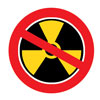No Nukes, Go Nukes: Two Views

Dr. Ken Schultz, a registered nuclear engineer, is the California-based operations director for the energy group at General Atomics and a past board member of the American Nuclear Society. His current specialty is developing hydrogen from nuclear power.

Is expansion of nuclear power a feasible way to avoid greenhouse gas emissions?
Yes, it certainly is. Stopping the emission of carbon dioxide (CO2) is the first step, and you can use nuclear power for electricity and to produce hydrogen for transportation fuels without it emitting virtually any CO2.
How much greenhouse gas is created by ancillary nuclear processes—uranium mining and milling, transportation, waste storage, etc.? Even with those emissions taken into account, is nuclear power climate-friendly?
In mining uranium or making concrete and steel to build reactors, CO2 is emitted, but the same is true of other climate-friendly energy sources, including solar. In fact, if you look at the lifecycle CO2 emissions from nuclear power they are about on the scale of hydroelectric generation, about half that of solar energy, and much, much lower than emissions from any fossil fuel source.
Is it feasible, given the lack of immediately affordable alternatives,for European countries like Germany to announce nuclear power phase-outs?
Germany announced its phase-out of nuclear energy something like 20 years ago, and in fact they have shut down a couple of nuclear power plants—Sweden has done the same. However, Sweden still produces almost 50 percent of its energy from nuclear, and Germany is similar to the U.S. As the dates come closer to shutdown, these countries realize they don’t have anything to replace these plants with except imported natural gas or coal. I expect we will see many of them, even Germany, quietly changing their minds. I’m a great proponent of solar and wind, but you can’t expect the grid to be stable when more than 20 percent of your power sources are intermittent, and you don’t have something to back them up when they’re down.
Do new generation plant designs offer solutions to making nuclear power a safer, better solution for our energy future?
I think so, but my company, General Atomics, is one of the leaders developing these Type IV plants. It’s safer to work in a nuclear plant than in an office building, in terms of expected industrial injuries. But it’s active safety: there are redundant pumps and cooling systems, and all that equipment has to be paid for. If we could achieve a system of truly passive safety, it would allow us to build a much safer and cheaper nuclear plant. And that’s where the Generation IV designs are going. They’re all helium cooled, with higher efficiency producing more electricity for the fuel you use and the waste you produce. And the higher temperatures they operate at can produce high-efficiency hydrogen, too.

Alden Meyer is director of strategy and policyfor the Union of Concerned Scientists (UCS), and is its principal advocate on national and international policy responses to the threat of global climate change. Before coming to UCS in 1989, he served as executive director of the League of Conservation Voters, Americans for the Environment and Environmental Action.

Is expansion of nuclear power a feasible way to avoid greenhouse gas emissions?There is no silver bullet for "solving" global warming, so we should consider all options for reducing heat-trapping emissions. But prudence dictates that we develop and deploy those technologies that achieve the largest reductions most quickly with the lowest cost and risk. Nuclear power today does not meet those criteria.
Moreover, a single major accident or act of sabotage would derail nuclear expansion, so the safety, security, waste and economic problems that now afflict it must be fixed. Instead of expanding U.S. nuclear capacity, we can significantly cut our emissions by reducing energy demand and improving the efficiency of our energy supply. We also can dramatically increase our use of a wide variety of clean, renewable technologies.
How much greenhouse gas is created by ancillary nuclear processes—uranium mining and milling, transportation, waste storage, etc.? Even with those emissions taken into account, is nuclear power climate-friendly?
A report released last month by the Oxford Research Group found that nuclear power’s carbon emissions "lie somewhere between renewable energy sources and fossil fuels." The report estimates that while coal—the primary source of electric power in the U.S.—produces 755 grams of carbon per kilowatt hour, the range for nuclear is from 10 to 150 grams per kilowatt hour. Wind power is 11 to 37 grams. Others have found that full life-cycle carbon emissions for U.S. nuclear and solar electric technologies are roughly comparable. Over the long run, however, there is no reason why the nuclear fuel cycle (or renewable energy production) could not be powered largely by carbon-neutral energy sources, creating the potential for virtually no lifecycle emissions.Are there certain conditions (a solution to the storage problem perhaps, or stringent safety standards) under which UCS could support an expansion of nuclear power?
UCS could support the expansion of nuclear power at some time in the future if—and only if—the unique safety, security, proliferation and waste disposal issues associated with the technology have been meaningfully addressed. The NRC needs comprehensive reform.
Is it feasible, given the lack of immediately affordable alternatives,for European countries like Germany to announce nuclear power phaseouts?
This question inaccurately assumes that there is a "lack of immediately affordable alternatives." Germany and other European countries are aggressively expanding power generation from wind and other renewable resources, even as they pursue a wide range of energy-efficiency improvements in every sector of their economies.
Do new generation plant designs offer solutions to making nuclear power a safer, better solution for our energy future?
While some argue that new plant designs will be much safer, these claims are difficult to evaluate because they are based largely on safety assessments that have not been validated by actual operational experience. While certain design features would correct major safety deficiencies, the associated benefits could be offset by other factors, such as cost-cutting actions that reduce safety margins, lack of operating experience, and the need in some cases to develop advanced materials that will have to perform under punishing conditions.
If nuclear power is not the answer, what is? Can renewable energy be ramped up to meet the climate challenge? What about conservation?
The government should adopt policies that maximize energy efficiency and conservation, increase the use of renewable energy resources, and eliminate barriers to existing non-nuclear technologies that can reduce global warming emissions. Such policies provide the best prospect for the large near-term reductions in global warming emissions that are needed to stabilize the global average tem
perature at a reasonably safe level. The government should create conditions under which energy prices would reflect the full cost of global warming emissions by setting emission targets and establishing a mandatory revenue-neutral carbon tax or cap-and-trade system.
JIM MOTAVALLI is editor of E.

